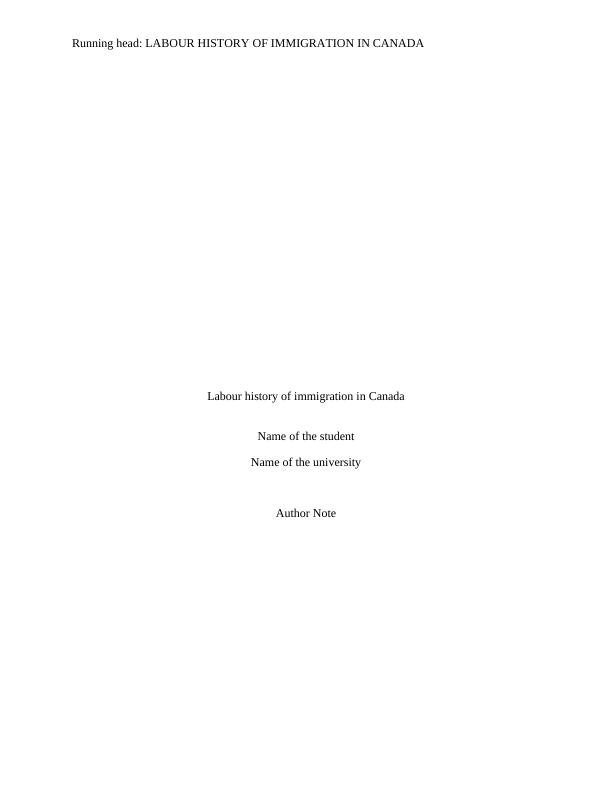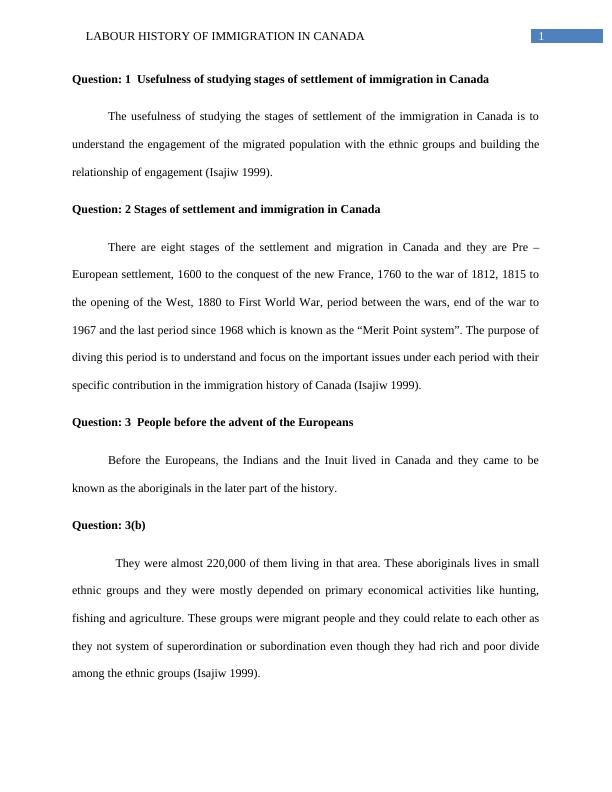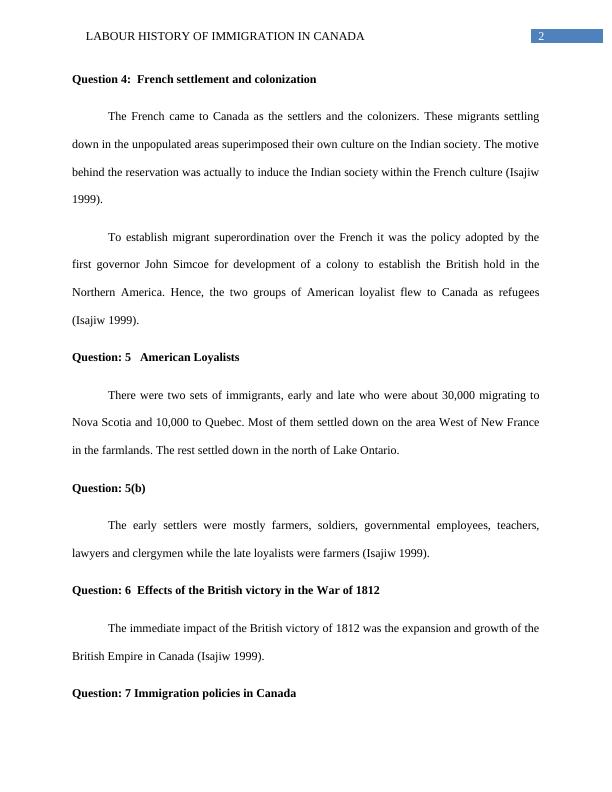Labour History of Immigration in Canada - Desklib
Added on 2023-04-24
8 Pages1601 Words155 Views
Running head: LABOUR HISTORY OF IMMIGRATION IN CANADA
Labour history of immigration in Canada
Name of the student
Name of the university
Author Note
Labour history of immigration in Canada
Name of the student
Name of the university
Author Note

1LABOUR HISTORY OF IMMIGRATION IN CANADA
Question: 1 Usefulness of studying stages of settlement of immigration in Canada
The usefulness of studying the stages of settlement of the immigration in Canada is to
understand the engagement of the migrated population with the ethnic groups and building the
relationship of engagement (Isajiw 1999).
Question: 2 Stages of settlement and immigration in Canada
There are eight stages of the settlement and migration in Canada and they are Pre –
European settlement, 1600 to the conquest of the new France, 1760 to the war of 1812, 1815 to
the opening of the West, 1880 to First World War, period between the wars, end of the war to
1967 and the last period since 1968 which is known as the “Merit Point system”. The purpose of
diving this period is to understand and focus on the important issues under each period with their
specific contribution in the immigration history of Canada (Isajiw 1999).
Question: 3 People before the advent of the Europeans
Before the Europeans, the Indians and the Inuit lived in Canada and they came to be
known as the aboriginals in the later part of the history.
Question: 3(b)
They were almost 220,000 of them living in that area. These aboriginals lives in small
ethnic groups and they were mostly depended on primary economical activities like hunting,
fishing and agriculture. These groups were migrant people and they could relate to each other as
they not system of superordination or subordination even though they had rich and poor divide
among the ethnic groups (Isajiw 1999).
Question: 1 Usefulness of studying stages of settlement of immigration in Canada
The usefulness of studying the stages of settlement of the immigration in Canada is to
understand the engagement of the migrated population with the ethnic groups and building the
relationship of engagement (Isajiw 1999).
Question: 2 Stages of settlement and immigration in Canada
There are eight stages of the settlement and migration in Canada and they are Pre –
European settlement, 1600 to the conquest of the new France, 1760 to the war of 1812, 1815 to
the opening of the West, 1880 to First World War, period between the wars, end of the war to
1967 and the last period since 1968 which is known as the “Merit Point system”. The purpose of
diving this period is to understand and focus on the important issues under each period with their
specific contribution in the immigration history of Canada (Isajiw 1999).
Question: 3 People before the advent of the Europeans
Before the Europeans, the Indians and the Inuit lived in Canada and they came to be
known as the aboriginals in the later part of the history.
Question: 3(b)
They were almost 220,000 of them living in that area. These aboriginals lives in small
ethnic groups and they were mostly depended on primary economical activities like hunting,
fishing and agriculture. These groups were migrant people and they could relate to each other as
they not system of superordination or subordination even though they had rich and poor divide
among the ethnic groups (Isajiw 1999).

2LABOUR HISTORY OF IMMIGRATION IN CANADA
Question 4: French settlement and colonization
The French came to Canada as the settlers and the colonizers. These migrants settling
down in the unpopulated areas superimposed their own culture on the Indian society. The motive
behind the reservation was actually to induce the Indian society within the French culture (Isajiw
1999).
To establish migrant superordination over the French it was the policy adopted by the
first governor John Simcoe for development of a colony to establish the British hold in the
Northern America. Hence, the two groups of American loyalist flew to Canada as refugees
(Isajiw 1999).
Question: 5 American Loyalists
There were two sets of immigrants, early and late who were about 30,000 migrating to
Nova Scotia and 10,000 to Quebec. Most of them settled down on the area West of New France
in the farmlands. The rest settled down in the north of Lake Ontario.
Question: 5(b)
The early settlers were mostly farmers, soldiers, governmental employees, teachers,
lawyers and clergymen while the late loyalists were farmers (Isajiw 1999).
Question: 6 Effects of the British victory in the War of 1812
The immediate impact of the British victory of 1812 was the expansion and growth of the
British Empire in Canada (Isajiw 1999).
Question: 7 Immigration policies in Canada
Question 4: French settlement and colonization
The French came to Canada as the settlers and the colonizers. These migrants settling
down in the unpopulated areas superimposed their own culture on the Indian society. The motive
behind the reservation was actually to induce the Indian society within the French culture (Isajiw
1999).
To establish migrant superordination over the French it was the policy adopted by the
first governor John Simcoe for development of a colony to establish the British hold in the
Northern America. Hence, the two groups of American loyalist flew to Canada as refugees
(Isajiw 1999).
Question: 5 American Loyalists
There were two sets of immigrants, early and late who were about 30,000 migrating to
Nova Scotia and 10,000 to Quebec. Most of them settled down on the area West of New France
in the farmlands. The rest settled down in the north of Lake Ontario.
Question: 5(b)
The early settlers were mostly farmers, soldiers, governmental employees, teachers,
lawyers and clergymen while the late loyalists were farmers (Isajiw 1999).
Question: 6 Effects of the British victory in the War of 1812
The immediate impact of the British victory of 1812 was the expansion and growth of the
British Empire in Canada (Isajiw 1999).
Question: 7 Immigration policies in Canada

End of preview
Want to access all the pages? Upload your documents or become a member.
Related Documents
Labour history of immigration in Canada Question 2022lg...
|8
|1558
|15
Labour History of Immigration in Canada and aboriginal.lg...
|8
|1314
|19
The Royal Proclamation of 1763lg...
|8
|1958
|497
Assignment on Film Response on Multiculturalism in Canadalg...
|6
|1398
|20
